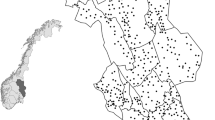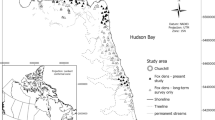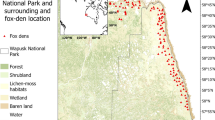Abstract
During the last century, the red fox (Vulpes vulpes) has expanded its distribution into the Arctic, where it competes with the arctic fox (Vulpes lagopus), an ecologically similar tundra predator. The red fox expansion correlates with climate warming, and the ultimate determinant of the outcome of the competition between the two species is hypothesized to be climate. We conducted aerial and ground fox den surveys in the northern Yukon (Herschel Island and the coastal mainland) to investigate the relative abundance of red and arctic foxes over the last four decades. This region has undergone the most intense warming observed in North America, and we hypothesized that this climate change led to increasing dominance of red fox over arctic fox. Results of recent surveys fall within the range of previous ones, indicating little change in the relative abundance of the two species. North Yukon fox dens are mostly occupied by arctic fox, with active red fox dens occurring sympatrically. While vegetation changes have been reported, there is no indication that secondary productivity and food abundance for foxes have increased. Our study shows that in the western Arctic of North America, where climate warming was intense, the competitive balance between red and arctic foxes changed little in 40 years. Our results challenge the hypotheses linking climate to red fox expansion, and we discuss how climate warming’s negative effects on predators may be overriding positive effects of milder temperatures and longer growing seasons.





Similar content being viewed by others
References
Alunik I, Kolausok ED, Morrison D (2003) Across time and tundra: the Inuvialuit of the Western Arctic. University of Washington Press, Seattle
Andriashek D, Kiliaan HPL, Taylor MK (1985) Observations on foxes, Alopex lagopus and V. vulpes, and wolves, C. lupus on the off-shore sea ice of northern Labrador. Can Field Nat 99:86–89
Angerbjörn A, Tannerfeldt M, Erlinge S (1999) Predator-prey relationships: arctic foxes and lemmings. J Anim Ecol 68:34–49
Audet AM, Robbins CB, Larivière S (2002) Alopex lagopus. Mamm Species No 713
Barber DG, Galley R, Asplin MG, De Abreu R, Warner K-A, Pućko M, Gupta M, Prinsenberg S, Julien S (2009) Perennial pack ice in the southern Beaufort Sea was not as it appeared in the summer of 2009. Geophys Res Lett 36:L24501
Bartoń KA, Zalewski A (2007) Winter severity limits red fox populations in Eurasia. Global Ecol Biogeogr 16:281–289
Careau V, Giroux J-F, Gauthier G, Berteaux D (2008) Surviving on cached food–the energetics of egg-caching by arctic foxes. Can J Zool 86:1217–1223
Cavallini P (1995) Variation in the body size of the red fox. Ann Zool Fenn 32:421–427
Choi SC, Stablein DM (1982) Practical tests for comparing two proportions in incomplete data. Appl Stat 31:256–262
Dalén L, Elmhagen B, Angerbjörn A (2004) DNA analysis on fox faeces and competition induced niche shifts. Mol Ecol 13:2389–2392
Dalerum F, Tannerfeldt M, Elmhagen B, Becker D, Angerbjörn A (2002) Distribution, morphology and use of arctic fox A. lagopus dens in Sweden. Wildl Biol 8:185–192
Davis S (1977) Size variation of the fox, V. vulpes, in the palaearctic region today, and in Israel during the late Quaternary. J Zool 182:343–351
Dyke AS, Prest VK (1987) Late Wisconsin and Holocene history of the Laurentide ice sheet (map 1703A, sheet 1). Géogr Phys Quatern 41:237–263
Eberhardt WL (1977) The biology of arctic and red foxes on the north slope. Dissertation, University of Alaska
Eberhardt LE, Garrott RA, Hanson WC (1983) Den use by arctic foxes in northern Alaska. J Mammal 64:97–102
Ekbohm G (1982) On testing the equality of proportions in the paired case with incomplete data. Psychometrika 47:115–118
Elmhagen B, Rushton SP (2007) Trophic control of mesopredators in terrestrial ecosystems: top-down or bottom-up? Ecol Lett 10:197–206
Elmhagen B, Tannerfeldt M, Angerbjörn A (2002) Food-niche overlap between arctic and red foxes. Can J Zool 80:1274–1285
Fancy SG, Whitten KR, Russell DE (1994) Demography of the Porcupine caribou herd, 1983–1992. Can J Zool 72:840–846
Fay FH, Stephenson RO (1989) Annual, seasonal, and habitat-related feeding habits of the arctic fox (A. lagopus) on St. Lawrence Island, Bering Sea. Can J Zool 67:1986–1994
Frafjord K (1995) Summer food habits of arctic foxes in the alpine region of southern Scandinavia, with a note on sympatric red foxes. Ann Zool Fenn 32:111–116
Frafjord K (2000) Do arctic and red foxes compete for food? Z Für Säugetierkd 65:350–359
Frafjord K (2003) Ecology and use of arctic fox A. lagopus dens in Norway: tradition overtaken by interspecific competition? Biol Conserv 111:445–453
Frafjord K, Becker D, Angerbjörn A (1989) Interactions between arctic and red foxes in Scandinavia–predation and aggression. Arctic 42:354–356
Fuglesteg BN, Haga ØE, Folkow LP, Fuglei E, Blix AS (2006) Seasonal variations in basal metabolic rate, lower critical temperature and responses to temporary starvation in the arctic fox (A. lagopus) from Svalbard. Polar Biol 29:308–319
Gruyer N, Gauthier G, Berteaux D (2008) Cyclic dynamics of sympatric lemming populations on Bylot Island, Nunavut, Canada. Can J Zool 86:910–917
Hansen J, Sato M, Ruedy R, Lo K, Lea DW, Medina-Elizade M (2006) Global temperature change. P Natl Acad Sci USA 103:14288–14293
Hardin G (1960) The competitive exclusion principle. Science 131:1292–1297
Henden J-A, Ims RA, Yoccoz NG, Hellström P, Angerbjörn A (2010) Strength of asymetric competition between predators in food webs ruled by fluctuating prey: the case of foxes in tundra. Oikos 119:27–34
Hersteinsson P, Macdonald DW (1982) Some comparisons between red and arctic foxes, V. vulpes and A. lagopus, as revealed by radio tracking. Symp Zool Soc Lond 49:259–289
Hersteinsson P, Macdonald DW (1992) Interspecific competition and the geographical distribution of red and arctic foxes V. vulpes and A. lagopus. Oikos 64:505–515
Hersteinsson P, Angerbjörn A, Frafjord K, Kaikusalo A (1989) The arctic fox in Fennoscandia and Iceland: management problems. Biol Conserv 49:67–81
IPCC (2007) Climate change 2007: synthesis report. In: Pachauri RK, Reisinger A (eds) Contribution of working groups I. II and III to the fourth assessment report of the intergovernmental panel on climate change IPCC, Geneva
Irving L, Krog H, Monson M (1955) The metabolism of some Alaskan animals in winter and summer. Physiol Zoöl 28:173–185
Jędrzejewski W, Jędrzejewska B (1992) Foraging and diet of the red fox V. vulpes in relation to variable food resources in Białowieża National Park, Poland. Ecography 15:212–220
Kennedy CE, Smith CAS, Cooley A (2001) Observations of change in the cover of polargrass, A. latifolia, and arctic lupine, L. arcticus, in upland tundra on Herschel Island, Yukon Territory. Can Field Nat 115:323–328
Killengreen ST, Ims RA, Yoccoz NG, Bråthen KA, Henden J-A, Schott T (2007) Structural characteristics of a low Arctic tundra ecosystem and the retreat of the Arctic fox. Biol Conserv 135:475–488
Killengreen ST, Lecomte N, Ehrich D, Schott T, Yoccoz NG, Ims RA (2011) The importance of marine vs. human-induced subsidies in the maintenance of an expanding mesocarnivore in the arctic tundra. J Anim Ecol 80:1049–1060
Kittel TGF, Baker BB, Higgins JV, Haney JC (2010) Climate vulnerability of ecosystems and landscapes on Alaska’s North Slope. Reg Environ Change 11:249–264
Klir JJ, Heath JE (1992) Metabolic rate and evaporative water loss at different ambient temperatures in two species of fox: the red fox (V. vulpes) and the Arctic fox (A. lagopus). Comp Biochem Phys A 101:705–707
Krebs CJ, Kenney AJ, Gilbert S et al (2002) Synchrony in lemming and vole populations in the Canadian Arctic. Can J Zool 80:1323–1333
Krebs CJ, Danell K, Angerbjörn A et al (2003) Terrestrial trophic dynamics in the Canadian Arctic. Can J Zool 81:827–843
Krebs CJ, Reid D, Kenney AJ, Gilbert S (2011) Fluctuations in lemming populations in north Yukon, Canada, 2007–2010. Can J Zool 89:297–306
Larivière S, Pasitschniak-Arts M (1996) V. vulpes. Mammal Species No 537
Macdonald RW, Carmack EC, McLaughlin FA, Falkner KK, Swift JH (1999) Connections among ice, runoff and atmospheric forcing in the Beaufort Gyre. Geophys Res Lett 26:2223–2226
Mack MC, Schuur EAG, Bret-Harte MS, Shaver GR, Chapin FS III (2004) Ecosystem carbon storage in arctic tundra reduced by long-term nutrient fertilization. Nature 431:440–443
Mackay JR (1959) Glacier ice-thrust features of the Yukon coast. Geogr Bull 13:5–21
Macpherson AH (1964) A northward range extension of the red fox in the eastern Canadian Arctic. J Mammal 45:138–140
Marsh DB (1938) The influx of the red fox and its colour phases into the barren lands. Can Field Nat 52:60–61
Murray DL, Larivière S (2002) The relationship between foot size of wild canids and regional snow conditions: evidence for selection against a high footload? J Zool 256:289–299
Myers-Smith IH, Hik DS, Kennedy C, Cooley D, Johnstone JF, Kenney AJ, Krebs CJ (2011) Expansion of canopy-forming willows over the twentieth century on Herschel Island, Yukon Territory, Canada. Ambio 40:610–623
Nagy MI (1988) Caribou exploitation at the Trail River site (northern Yukon). Dissertation, Simon Fraser University
Nolan JW, Goski BC, Wilde GW (1973) Atlas of wildlife habitat inventory maps for Environmental-Social Program, Northern Pipelines. Part of a wildlife habitat inventory of the Mackenzie Valley and the Northern Yukon. Canadian Wildlife Service, Ottawa
Pamperin NJ, Follmann EH, Petersen B (2006) Interspecific killing of an arctic fox by a red fox at Prudhoe Bay, Alaska. Arctic 59:361–364
Prestrud P (1991) Adaptations by the Arctic fox (A. lagopus) to the polar winter. Arctic 44:132–138
Rampton VN (1982) Quaternary geology of the Yukon Coastal Plain. Geol Surv Can Bull 317:1–49
Regehr EV, Amstrup SC, Stirling I (2006) Polar bear population status in the southern Beaufort Sea. US Geological Survey Open-File Report, Reston, No 2006–1337
Reid DG, Krebs CJ, Kenney AJ (1997) Patterns of predation on non-cyclic lemmings. Ecol Monogr 67:89–108
Rodnikova A, Ims RA, Sokolov A, Skogstad G, Sokolov V, Shtro V, Fuglei E (2011) Red fox takeover of arctic fox breeding den: an observation from Yamal Peninsula, Russia. Polar Biol 34:1609–1614
Roth JD (2002) Temporal variability in arctic fox diets as reflected in stable-carbon isotopes; the importance of sea ice. Oecologia 133:70–77
Roth JD (2003) Variability in marine resources affects arctic fox population dynamics. J Anim Ecol 72:668–676
Ruttan RA (1974) Arctic fox on the north slope of the Yukon Territory, 1972. In: Ruttant RA, Wooley DR (eds) Studies on furbearers associated with proposed pipeline routes in the Yukon and Northwest Territories. Biological Report Series, Canadian Arctic Gas Study Limited and Alaskan Arctic Gas Study Company Vol 9, pp 1–52
Ruttan RA, Wooley DR (1974) A study of furbearers associated with proposed pipeline routes in the Yukon Territory and Mackenzie River Valley, 1971. Biological Report Series, Canadian Arctic Gas Study Limited and Alaskan Arctic Gas Study Company, vol 8
Sanzone D, Streever B, Burgess B, Lukin J (eds) (2010) Long-term ecological monitoring in BP’s north slope oil fields: 2009 annual report. British Petroleum Exploration (Alaska) Inc, Anchorage
Scholander PF, Hock R, Walters V, Johnson F, Irving L (1950a) Heat regulation in some arctic and tropical mammals and birds. Biol Bull 99:237–258
Scholander PF, Walters V, Hock R, Irving L (1950b) Body insulation of some arctic and tropical mammals and birds. Biol Bull 99:225–236
Schuur EAG, Crummer KG, Vogel JG, Mack MC (2007) Plant species composition and productivity following permafrost thaw and thermokarst in Alaskan tundra. Ecosystems 10:280–292
Scott AJ, Seber GAF (1983) Difference of proportions from the same survey. Am Stat 37:319–320
Selås V, Vik JO (2006) Possible impact of snow depth and ungulate carcasses on red fox (V. vulpes) populations in Norway, 1897–1976. J Zool 269:299–308
Sklepkovych BO, Montevecchi WA (1996) Food availability and food hoarding behavior by red and arctic foxes. Arctic 49:228–234
Skrobov VD (1960) On the interrelations of the polar fox and the fox in the tundra of the Nenets national region. Zoologicheskii Zhurnal 39:469–471
Smith CAS, Kennedy CE, Hargrave AE, McKenna KM (1989) Soil and vegetation survey of Herschel Island, Yukon Territory. Yukon Soil Survey Report No 1, Agriculture Canada, Whitehorse
Smith CAS, Smits CMM, Slough BG (1992) Landform selection and soil modifications associated with arctic fox (A. lagopus) den sites in Yukon territory, Canada. Arctic Alpine Res 24:324–328
Smith CAS, Meikle JC, Roots CF (eds) (2004) Ecoregions of the Yukon Territory: biophysical properties of Yukon landscapes. PARC Technical Bulletin, Agriculture and Agri-Food Canada Bull 04–01, Summerland
Smits CMM, Slough BG (1993) Abundance and summer occupancy of arctic fox, A. lagopus, and red fox, V. vulpes, dens in the northern Yukon Territory, 1984–1990. Can Field Nat 107:13–18
Smits CMM, Smith CAS, Slough BG (1988) Physical characteristics of arctic fox (A. lagopus) dens in northern Yukon Territory, Canada. Arctic 41:12–16
Smits CMM, Slough BG, Yasui CA (1989) Summer food habits of sympatric arctic foxes, A. lagopus, and red foxes, V. vulpes, in the northern Yukon Territory. Can Field Nat 103:363–367
Spaans B, Blijleven HJ, Popov IU, Rykhlikova ME, Ebbinge BS (1998) Dark-bellied brent geese Branta bernicla bernicla forgo breeding when arctic foxes A. lagopus are present during nest initiation. Ardea 86:11–20
Stirling I (2002) Polar bear and seal in the eastern Beaufort Sea and Amundsen Gulf: a synthesis of population trends and ecological relationships over three decades. Arctic 55:59–76
Sturm M, Racine C, Tape K (2001) Increasing shrub abundance in the Arctic. Nature 411:546–547
Tang M-L, Tang N-S (2004) Exact test for comparing two paired proportions with incomplete data. Biometrical J 46:72–82
Tannerfeldt M, Angerbjörn A (1998) Fluctuating resources and the evolution of litter size in the arctic fox. Oikos 83:545–559
Tannerfeldt M, Elmhagen B, Angerbjörn A (2002) Exclusion by interference competition? The relationship between red and arctic foxes. Oecologia 132:213–220
Thomson PC (1995) A hybrid paired and unpaired analysis for the comparison of proportions. Stat Med 14:1463–1470
Walker MD, Wahren CH, Hollister RD et al (2006) Plant community responses to experimental warming across the tundra biome. P Natl Acad Sci USA 103:1342–1346
Wendler G, Shulski M, Moore B (2010) Changes in the climate of the Alaska North Slope and the ice concentration of the adjacent Beaufort Sea. Theor Appl Climatol 99:67–74
Wilson DJ, Krebs CJ, Sinclair T (1999) Limitation of collared lemming populations during a population cycle. Oikos 87:382–398
Zar JH (1999) Biostatistical analysis, 4th edn. Prentice Hall, Upper Saddle River
Acknowledgments
We thank Guillaume Szor, François Racine, Francis Taillefer, Andrew Fehr, Helen Slama, Alice Kenney, Elizabeth Hofer, Charles J. Krebs, and Scott Gilbert for field assistance. We thank Richard Gordon, Edward McLeod, Lee John Meyook, Jordan McLeod, Deon Arey, Sam McLeod, and Pierre Foisy for helping with field logistics. We thank helicopter pilots Florian Koch and Robert Ungar. We are grateful to Parks Canada for permission to work in Ivvavik National Park. We thank Bob Sagar for gathering climate data from the Komakuk Beach Environment Canada weather station database. Three reviewers made comments that improved this paper. Funding and support for this research come from the Natural Sciences and Engineering Research Council of Canada (grants to Dominique Berteaux, Alexander Graham Bell CGS-D graduate scholarship to Daniel Gallant), the International Polar Year program of Indian and Northern Affairs Canada, the ArcticNet Network of Centers of Excellence of Canada, the Wildlife Conservation Society Canada (Don Reid), the Polar Continental Shelf Program (PCSP), Natural Resources Canada, the Canada Research Chairs Program, the Aurora Research Institute, the Canadian Foundation for Innovation, the Centre d’Études Nordiques (CEN), the Northern Scientific Training Program (Indian and Northern Affairs Canada), and the Université du Québec à Rimouski. We thank J. Martin Bland at the University of York (York, United Kingdom) and Barbara K. Butland of St George’s Hospital Medical School (London, United Kingdom) for sharing their unpublished statistical procedure.
Author information
Authors and Affiliations
Corresponding authors
Appendix
Appendix
Procedure comparing proportions in overlapping samples (from Bland and Butland, unpublished)The procedure by J. M. Bland and B. K. Butland comparing proportions in overlapping samples (http://www.users.york.ac.uk/~mb55/overlap.pdf, accessed on March 4, 2011) calculates two differences of proportions: one for paired data (in our case, dens surveyed in each of the compared periods) and another for unpaired data (in our case, dens only surveyed in one of the periods). It then combines the calculated differences in a weighted average to produce a single difference of proportions. We used the procedure to obtain 95 % confidence intervals to decide whether differences between proportions were statistically significant. We pooled the survey data within the periods 1984–1990 and 2003–2010 and classified each den as having been used or not by foxes within each of the two survey periods. We describe below the calculations supporting Bland and Butland’s procedure, using symbols described in Table 2.
The difference (d) in the paired (p) dataset between the number of dens used in the first sample but unused in the second sample (n 10), and the number of dens unused in the first sample but used in the second sample (n 01) is:
with variance (Var):
while the difference in the number of dens used in the first (n x ) and second (n y ) samples in the unpaired (u) dataset is:
where k and m are the respective sample sizes of the two samples, with variance:
Combining these two difference estimates using a weighted (w) average, we get:
where:
and:
with variance:
The 95 % confidence interval is thus:
Rights and permissions
About this article
Cite this article
Gallant, D., Slough, B.G., Reid, D.G. et al. Arctic fox versus red fox in the warming Arctic: four decades of den surveys in north Yukon. Polar Biol 35, 1421–1431 (2012). https://doi.org/10.1007/s00300-012-1181-8
Received:
Revised:
Accepted:
Published:
Issue Date:
DOI: https://doi.org/10.1007/s00300-012-1181-8




